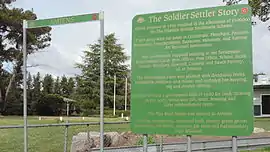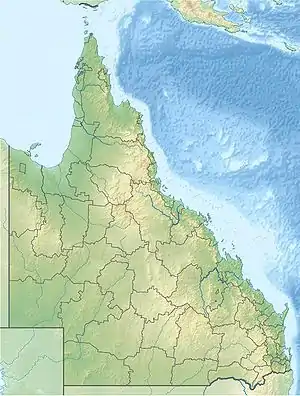Amiens, Queensland
Amiens is a rural locality in the Southern Downs Region, Queensland, Australia.[2] At the 2016 Australian Census, Amiens recorded a population of 293.[1]
| Amiens Queensland | |||||||||||||||
|---|---|---|---|---|---|---|---|---|---|---|---|---|---|---|---|
 Information board about the Pikedale soldier settlements, Amiens, 2015 | |||||||||||||||
 Amiens | |||||||||||||||
| Coordinates | 28.5887°S 151.809°E | ||||||||||||||
| Population | 293 (2016 census)[1] | ||||||||||||||
| • Density | 5.645/km2 (14.62/sq mi) | ||||||||||||||
| Postcode(s) | 4380 | ||||||||||||||
| Area | 51.9 km2 (20.0 sq mi) | ||||||||||||||
| |||||||||||||||
History

Following World War I, Amiens was one of the Pikedale soldier settlements established in the Granite Belt area of the Darling Downs.[3]
The name Amiens refers to the World War I battlefield in northern France, of special importance to the Australian Imperial Force in March–April 1918. The name was suggested by surveyor George Grant in 1920.[2]
Construction of the Amiens railway line commenced in 1919 and the line was opened on 7 June 1920.[4] Edward, Prince of Wales travelled the length of the Amiens branch in a royal train to officially open the line on 26 July 1920.[5]
Although the intention of the soldier settlement farms in the district was fruit growing, the fruit trees required a number of years before they would bear fruit and the government loans on the farms required immediate interest payments. Many soldier settlers turned to vegetable growing, both for their own use and to enable them to sell for a short-term income.[6]
Pikedale Soldier's Setttlement State School opened on 10 March 1919. In 1920 it was renamed Amiens State School.[7][8]
The railway line closed on 28 February 1974.[4] Fruit and vegetables are carried by road to the markets.
Heritage listings
Amiens has a number of heritage-listed sites, including:
- 17 Trevethan Lane: St Denys Anglican Church[9]
Economy

Amiens is a fruit and vegetable growing district. As the Granite Belt suffers from regular hail, many orchards are protected by hail nets. Traditionally hail nets were intended to prevent the hail from entering the orchard; however, the heavy hail would pool in the nets and break through onto the orchard below. Modern hail nets are designed to have gullies between the rows of the trees which allow the hail to fall into the orchards but avoiding the fruit on the trees.[10]

References
- Australian Bureau of Statistics (27 June 2017). "Amiens (State Suburb)". 2016 Census QuickStats. Retrieved 25 March 2018.

- "Amiens (entry Number)". Queensland Place Names. Queensland Government. Retrieved 15 March 2014.
- Randall, Brian (3 November 2014). "Pikedale soldier settlements". State Library of Queensland. Retrieved 2 June 2015.
- Southern Downs Steam Railway (2008). "Historical information: (Warwick) – Cottonvale – Amiens". Archived from the original on 6 January 2009. Retrieved 18 November 2008.
- QR Limited. "QR History – Royal goes by train". Archived from the original on 19 July 2008. Retrieved 18 November 2008.
- "Amiens, Thulimba, Applethorpe district". Queensland Places. Centre for the Government of Queensland, University of Queensland. Retrieved 2 June 2015.
- Queensland Family History Society (2010), Queensland schools past and present (Version 1.01 ed.), Queensland Family History Society, ISBN 978-1-921171-26-0
- "Opening and closing dates of Queensland Schools". Queensland Government. Retrieved 18 April 2019.
- "St Denys Anglican Church (entry 602530)". Queensland Heritage Register. Queensland Heritage Council. Retrieved 13 July 2013.
- "Hail lashes Stanthorpe region". Warwick Daily News. 28 October 2011. Retrieved 2 June 2015.
External links
| Wikimedia Commons has media related to |
- "Amiens, Thulimbah, Applethorpe District". Queensland Places. Centre for the Government of Queensland, University of Queensland.